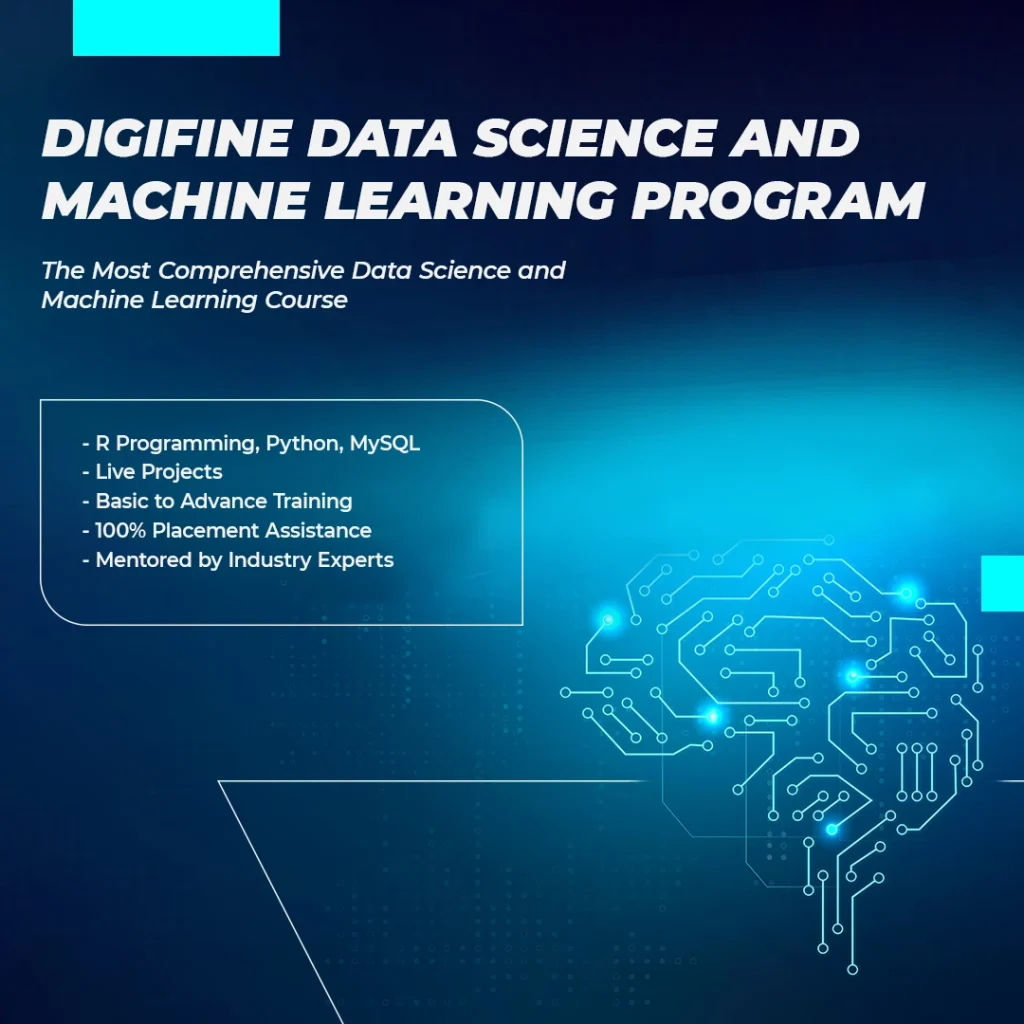

Why Digifine Data Science and Machine Learning Course in Mumbai?
Data science is one of the most in-demand skills in industry today. The demand for skilled Data Scientists who can communicate, analyze and evaluate data and get data-driven results, has never been greater.
Digifine Data Science and Machine Learning Course in Mumbai offers a most comprehensive syllabus which covers Python, R Programming, Machine Learning and industry tools like Anaconda, Jupyter, R Studio, etc. We also provide international certification and practical exposure which prepares students to bag top placements in Data Science and Machine Learning.
Digifine Data Science & Machine Learning Course in Mumbai Modules
- History of Python
- Why to learn python How is Python Different?
- Installing Python
- Using the interpreter
- Integrated Development
- Environments (IDE) How to run Python programs?
- Arithmetic operator Comparison Operator
Assignment Operator - Logical operator
- Bitwise operator
- Identity Operator
- Basics Defining function
- Function call Return statement Function with parameter and without parameter
- Function parameters
- Call by value or call by reference
- Local and global variable
- Recursion, Anonymous (lambda) function User define functions | Examples
- Course Review
- Understanding the versions of R Choosing the Best Version
- Downloading R Installing R
- Understanding R Environment
Complex Data Types in R: Vectors, Arrays, Matrices, Lists and Data Frame
- Introduction to Machine Learning
- Types of Machine learning
- Data understanding : real life example
- Why Machine learning is future
- Which skills are required for Machine learning
- Discussion on different packages used for ML
- Introduction to Decision tree
- Significance of using Decision Tree
- Different kinds of Decision Tree
- Random Forest
- Theory and mathematical concepts Entropy and Decision Tree
- Practical application on R and Python
- Introduction of clustering
- K-mean clustering Practical application on R and Python
- Introduction of Deep Learning, Scope of Deep Learning
- Understanding Artificial Neural Network(ANN)
- Introduction to python advance packages for Machine Learning: TensorFlow
Placement Post Data Sciene & Machine Learning Course in Mumbai
How do I make a career in Data Science and Machine Learning?
Data Science and Machine Learning are complex fields of study which can be mastered with thorough practice. It is recommended to study Data Science and Machine Learning from a premium institute which can provide you excellent guidance and live experience which will be extremely helpful in building a successful Data Science career. You could learn the fundamentals online with free sources but it is advised to take a professional course if you are looking to make a career in Data Science and Machine Learning.
Here are five things you can do right now to kick start your Data Science and Machine Learning career:
- Research fundamentals of Data Science and Machine Learning on the internet.
- Be informed about the industry.
- Network with other Data Scientists/Data Analysts.
- Enroll for a certified Data Science and Machine Learning course.
- Gain practical experience and create a portfolio for yourself.

Data Science and Machine Learning Course in Mumbai Key Features

- Practical Projects
- Industry Recognized Certification
- IBM Certification
- 180+ hours of live class
- 10 Industry Tools
- 20+ Skills
- One-on-one mentoring
- 100% placement assistance
- Post course support
Who Should Do This Course
Digifine Data Science and Machine Learning Course is for students who are passionate about Data Science and Machine Learning and want to make a career in it. If you want to learn the best Machine Learning course in Mumbai which offers an extensive syllabus and prepares students for the industry then do join this course.

Digifine Data Science & Machine Learning Course in Mumbai Student Reviews
Shreya Soni
Digital Marketing Manager, Adbizit
Talvinder Singh
Digital Marketing Associate, Group M
Darshil Doshi
Paid Media Specialist, Group M
Kashish Raghani
Creative Head, Adbizit
Pooja Shrimal
Sr. Media Planner, Tonic Worldwide
Nisha Vishwakarma
Programmatic Analytics, Publicis Groupe, Andheri
Register for Data Science & Machine Learning Course in Mumbai
Take a step forward into the digital marketing industry with Digifine!
FAQs
Data Science is a discipline which uses programming skills, domain expertise, mathematics and statistics to draw relevant insights from data.
Machine Learning is a department of computer science and Artificial Intelligence which provides systems the capability to operate from experience without being directly programmed to do so.
Data Science and Machine Learning are the most in-demand tech careers as of now and will be in the future. It is a lucrative career option for anyone who is interested.
No, to become a Data Scientist you don’t have to be from a science background. Anyone who is interested and has passion for learning can take this professional data science certificate.
No prior knowledge of coding is required to pursue this data science and machine learning certification.
Yes. Digifine’s course prepares its students to get the best placements as a fresher. The industry experts who teach the course train the students thoroughly, so as to have complete knowledge about Data Science.
If you miss any live class, you can attend any of the forthcoming batches in the year, without any additional cost.
We work with industry professionals and have collaborations with HRs from several companies, where students are placed post the completion of the course. We offer thorough training which guarantees the chances of our students getting hired.
Yes, as Python is great to use in Data Science and comes with all popular pre-loaded libraries. It’s an open-source, high-level language, and gives a great approach for a data scientist. Because of all of these major advantages, we train students in-depth on Python in Digifine Data Science and Machine Learning Course.
According to Glassdoor, the average package of a beginner Data Analyst is INR 5,00,000, in India. It is a lucrative career option for anyone who is interested.
Data Science is a complex field of study and requires thorough practice to master it. But with proper guidance and quality lectures, it is easy to understand with consistent practice. At Digifine, we have excellent trainers who guide students until they are confident in a subject.
The duration of Digifine Data Science and Machine Learning Course is 4 months including your practicals, assignments, projects, etc. Contact us regarding the same for more information.










